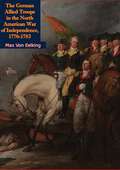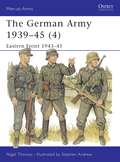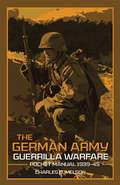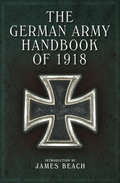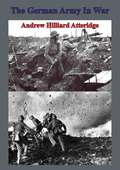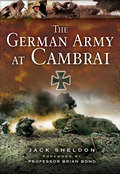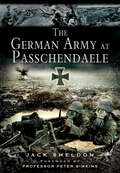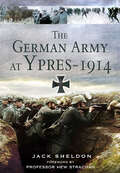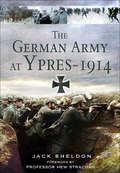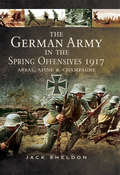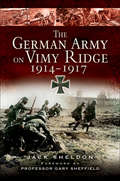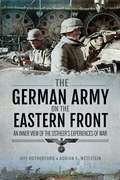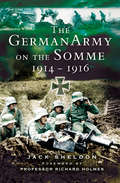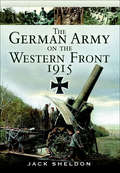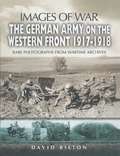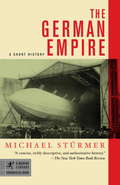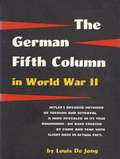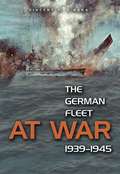- Table View
- List View
The German Allied Troops in the North American War of Independence, 1776-1783
by Max Von EelkingMax Von Eelking’s "The German Allied Troops in the North American War of Independence, 1776-1783" offers a meticulously detailed and authoritative account of the crucial role played by German auxiliary forces during the American Revolutionary War. This seminal work provides a comprehensive exploration of the contributions, experiences, and lasting impact of these troops, who were instrumental in many key battles and campaigns.Von Eelking, a distinguished historian and former military officer, draws upon an extensive array of primary sources, including military records, personal letters, and official reports, to paint a vivid picture of the German soldiers’ experiences. The book delves into the motivations behind the deployment of these troops, their recruitment and training, and the challenges they faced in adapting to the unfamiliar American terrain and climate."The German Allied Troops in the North American War of Independence" provides readers with an in-depth look at the diverse backgrounds and regiments that comprised these forces, including the well-known Hessians, as well as troops from Brunswick, Anhalt-Zerbst, and other German states. Von Eelking’s narrative highlights the strategic significance of their involvement, detailing their participation in pivotal battles such as Trenton, Saratoga, and Yorktown.This book is an invaluable resource for historians, military enthusiasts, and anyone interested in the multifaceted history of the American Revolution. Von Eelking’s scholarly yet accessible writing style ensures that readers gain a profound understanding of the German auxiliary troops’ significant and often overlooked contributions to the war effort."The German Allied Troops in the North American War of Independence, 1776-1783" stands as a testament to the bravery and resilience of these soldiers, and it enriches our understanding of the international dimensions of America’s fight for independence. Max Von Eelking’s work continues to be a definitive reference on this fascinating aspect of Revolutionary War history.
The German Army 1939-45
by Nigel Thomas Stephen AndrewOn 1 September 1939, when Germany attacked Poland, the Wehrmacht numbered 3,180,000 men. It eventually expanded to 9,500,000, and on 8-9 May 1945, the date of its unconditional surrender on the Western and Eastern Fronts, it still numbered 7,800,000. The Blitzkrieg period, from 1 September 1939 to 25 June 1940, was 10 months of almost total triumph for the Wehrmacht, as it defeated every country, except Great Britain, that took the field against it. In this first of five volumes examining the German Army of World War II (1939-1945), Nigel Thomas examines the uniforms and insignia of Hitler's Blitzkrieg forces, including an overview of the Blitzkrieg campaign itself.
The German Army 1939-45: Eastern Front 1943-45
by Nigel Thomas Stephen AndrewIn early 1943 the annihilation of the 6th Army at Stalingrad marked the irreversible turning-point of the war in the East. Despite occasional local successes gained in the face of great odds – testimony to the Wehrmacht's extraordinary resilience – from now on Germany was on the defensive. Despite Hitler's damaging interference the quality of German field leadership, and of new weapons, remained high; but each new Soviet offensive pushed the front line closer to – and finally, across – the borders of the Reich. In this fourth title of their sequence author and artist describe and illustrate the developments in unit organization, uniforms and equipment during 1943–45, including information on European and Eastern volunteer units; text and illustrations are supported by detailed tables. *Men-at-Arms 311, 316, 326, 330 and 336 are also available in a single volume special edition titled 'German Army in World War II'.
The German Army Guerrilla Warfare: Pocket Manual, 1939–45 (The Pocket Manual Series)
by Charles D. MelsonAn exploration of German World War II small-scale military strategy, edited by the former chief historian of the U.S. Marines. While small wars are not new, how they should be fought by a modern industrial nation is still very much a matter for debate. It is thus worth paying heed now to the experiences of another power which once encountered the same problems. This pocket manual examines German analysis of the problem, covering experiences from the Napoleonic era to the Third Reich, based upon the historical analysis, Kleinkrieg, provided to the German High Command by Arthur Ehrhardt in 1935 (republished in 1942 and 1944), and the Bandenbekampfung (Fighting the Guerrilla Bands) document provided to Germany&’s OKW in 1944. In both, conditions that were specific to broader military operations were separated from circumstances in occupation campaigns, and the new background in the German experience in suppressing rebellion during the Second World War is presented. Avoiding ideological biases, this manual examines the purely military problem as seen by professionals. Rediscovered and presented in English, these German thoughts on how best to fight small wars have been edited and annotated by Charles D. Melson, former chief historian for the U.S. Marine Corps. &“The German attitude to guerrilla war was far more complex than stereotypical brutality for the sake of brutality.&” —Stephen G. Fritz, PhD, author of Ostkrieg &“A highly accessible introduction to an important, but frequently neglected, aspect of German military history as well for those interested in guerrilla warfare.&” —Bruce I. Gudmundsson, PhD, U.S. Marine Corps University, author of On Artillery
The German Army Handbook of 1918
by David NashAn exact reproduction of the landmark British assessment of German military capability in the final months of World War I. Compiled by British Intelligence, for restricted official issue by the General Staff, The German Army Handbook of April 1918 is a comprehensive assessment of the German Army during the latter stages of the First World War. Illustrated throughout with plates, diagrams, charts, tables, and maps, it provides a detailed breakdown of the army, covering all aspects from recruiting and training, mobilization, command and organization, weapons and signals to transportation, medical and veterinary services, and uniform. There are also two maps, showing Army Corps Districts, and Zones of Administration and Lines of Command in June 1917. The German Army Handbook of 1918 was a remarkable achievement. It provides solutions to many questions that histories of the First World War and accounts of its battles are unable to answer. It shows how the static conventions of trench warfare usurped the traditional role of cavalry, and how the German Army was able to take advantage of the dominance of the machine gun on the Western Front in 1915.
The German Army In War
by Andrew Hillard AtteridgeA. H. Atteridge penned many books on the subject of warfare, concentrating mainly on the Napoleonic period and the German army in the run up to the First World War. War Correspondent of the Daily Chronicle in the Sudan campaign of 1896, he was also special correspondent at manoeuvres of various foreign armies, and was an officer in the London Irish Rifles from 1893 to 1905. Some of the important military works written by him included Towards Khartoum, Wars of the Nineties, Napoleon's Brothers, Joachim Murat, and Marshal Foch. An acknowledged expert, his writing style is fluid and pacy without losing any of his authoritative knowledge.Author- Andrew Hilliard Atteridge (1844-1941)Text taken, whole and complete, from the edition published in New York, McBride, Nast & co. 1915.Original Page Count - 127 pages.
The German Army at Cambrai
by Jack SheldonThis latest German Army book by Jack Sheldon covers a shorter (three week) timeframe than his earlier works. After an introductory chapter tracing the development of the Hindenburg Line, the author concentrates on German aspects of the bitterly fought battle of Cambrai from 20 November to 6 December 1917.The narrative splits easily into two parts. First the defensive battle 20 29 November followed by the counter-attack which saw the German Army regain not only most of the ground lost in the opening phase but more besides. Detailed descriptions are given of the struggle for Flesquires Ridge and the see-saw battles for key terrain, including Bourlon Wood, as the German Army rushed reinforcements to the sectors under attack before we witness the German offensive.As with his other books full use is made of primary source material from the Munich Kriegsarchiv, the Hauptstaatsarchiv in Stuttgart, regimental histories and personal accounts. Of particular interest are the controversial interventions in operational matters of Ludendorf which were sharply criticized by Crown Prince Rupprecht. But for many the most fascinating aspect will be the experiences of the front line soldiers.
The German Army at Cambrai
by Jack SheldonThis latest German Army book by Jack Sheldon covers a shorter (three week) timeframe than his earlier works. After an introductory chapter tracing the development of the Hindenburg Line, the author concentrates on German aspects of the bitterly fought battle of Cambrai from 20 November to 6 December 1917.The narrative splits easily into two parts. First the defensive battle 20 29 November followed by the counter-attack which saw the German Army regain not only most of the ground lost in the opening phase but more besides. Detailed descriptions are given of the struggle for Flesquires Ridge and the see-saw battles for key terrain, including Bourlon Wood, as the German Army rushed reinforcements to the sectors under attack before we witness the German offensive.As with his other books full use is made of primary source material from the Munich Kriegsarchiv, the Hauptstaatsarchiv in Stuttgart, regimental histories and personal accounts. Of particular interest are the controversial interventions in operational matters of Ludendorf which were sharply criticized by Crown Prince Rupprecht. But for many the most fascinating aspect will be the experiences of the front line soldiers.
The German Army at Passchendaele
by Jack SheldonThis WWI military history presents a detailed account of the third Battle of Ypres, in the Belgian village of Passchendaele, from the German perspective. More than a century since the epic battle, the name Passchendaele has lost none of its power to shock and dismay. Reeling from the huge losses in earlier battles, the German army was in no shape to absorb the impact of the Battle of Messines and the subsequent attritional struggle. Throughout the fighting on the Somme the German army had always felt that it had the ability to counter Allied thrusts, but following the shock reverses of April and May 1917, they introduced new tactics of flexible defense. When these tactics proved insufficient, the German defenders&’ confidence was deeply shaken. Yet, despite being outnumbered, outgunned, and subjected to relentless, morale-sapping shelling and gas attacks, German soldiers in the trenches still fought extraordinarily hard. The German army drew comfort from the realization that, although it had yielded ground and paid a huge price in casualties, its morale was essentially intact. The British were no closer to a breakthrough in Flanders at the end of the battle than they had been many weeks earlier.
The German Army at Ypres 1914
by Jack SheldonThe WWI military expert presents his authoritative study of the German Army&’s operations during the First Battle of Ypres. Soon after the First World War broke out in 1914, Allied and German forces attempted to outflank each other in a series of battles along the Western Front. Some of the most intense fighting came in Flanders, Belgium, at the First Battle of Ypres. It was during this battle that generals on both sides confronted the end of maneuvering as they became locked into positional warfare. Historian Jack Sheldon is a renowned expert on the German Army during WWI. In this groundbreaking study of the First Battle of Ypres, he presents a tactical narrative of German operation at the regimental and battalion level. Focusing on the battles around Ypres against the British Expeditionary Force, Sheldon also analyses the fighting against the French and Belgian armies. This book also features the first complete account of German army operations in the battles north of Lille in the late autumn of 1914. Drawing on extensive research into German sources, Sheldon presents the testimony of German participants, shedding light on the experiences of the fighting troops at regimental level and below. He supports this material with historical context and commentary, as well as evidence from senior commanders.
The German Army at Ypres 1914
by Jack SheldonThe WWI military expert presents his authoritative study of the German Army&’s operations during the First Battle of Ypres. Soon after the First World War broke out in 1914, Allied and German forces attempted to outflank each other in a series of battles along the Western Front. Some of the most intense fighting came in Flanders, Belgium, at the First Battle of Ypres. It was during this battle that generals on both sides confronted the end of maneuvering as they became locked into positional warfare. Historian Jack Sheldon is a renowned expert on the German Army during WWI. In this groundbreaking study of the First Battle of Ypres, he presents a tactical narrative of German operation at the regimental and battalion level. Focusing on the battles around Ypres against the British Expeditionary Force, Sheldon also analyses the fighting against the French and Belgian armies. This book also features the first complete account of German army operations in the battles north of Lille in the late autumn of 1914. Drawing on extensive research into German sources, Sheldon presents the testimony of German participants, shedding light on the experiences of the fighting troops at regimental level and below. He supports this material with historical context and commentary, as well as evidence from senior commanders.
The German Army in World War I
by Gerry Embleton Nigel ThomasIn August 1914 the mobilization of Imperial Germany's 800,000-strong army ushered in the first great war of the modern age - a war which still stands as the greatest slaughter of soldiers in history. That German Army is also the best example of a particular period of military thought, when virtually the whole manpower of the European nations was integrated into mass conscript armies, supported by several age categories of reservists and by dedicated industrial and transport systems. In this first of three volumes the author offers an extraordinary mass of information, in text and tables, illustrated by photographs and colour plates.
The German Army in World War I
by Ramiro Bujeiro Nigel ThomasThis third volume of a mini-series covering the German forces in World War I (1914-1918) examines the troops that fought during the climax of the war on all fronts: the last great battles of attrition in the West (Arras, Messines, 3rd Ypres - Passchendaele/Langemarck - and Cambrai, 1917) and the collapse of Russia in the East. The 'Kaiserschlacht' campaign is covered, as are the German operations in Italy, the Balkans, and in support of Turkey in the Middle East. Uniform changes during this period reflected the introduction of new tactics and weapons and new types of troops, such as tanks and assault battalions.
The German Army in the Spring Offensives 1917: Arras, Aisne & Champagne
by Jack Sheldon&“A detailed and vivid account of the battles on three deadly fronts. The research is breathtaking, the assembly of the story is masterful.&”—The Long, Long Trail After the great battles of 1916, the Allied Armies planned to launch massive attacks North and South of the Somme. The German withdrawal to the Hindenburg Line in March 1917 forced the new French CinC General Nivelle to rethink and the French embarked on a major attack in the Aisne area and along the Chemin des Dames, with the British conducting large-scale diversionary operations around Arras. The French suffered disastrously and, rendered incapable of further offensive operations, it fell to the British to step up the pressure, which they did albeit at a terrible price. This latest work by expert Jack Sheldon describes the event of Spring 1917 from the defenders&’ perspective. In particular it reveals the methods the Germans used to smash the French attacks and Oberst Fritz von Lossberg&’s transformation of the defenses in the Arras front. Actions described in detail are the bitter battles around Monchy Le Preun, the Roeux Chemical works and Bullecourt as well as the capture of Vimy Ridge. &“This volume of Jack Sheldon&’s highly detailed series of books on the German Army in the Great War follows his usual effective model—employing the clear writing and knowledge learned from dogged, detailed research . . . It would be impossible to offer other than the highest recommendation for this book.&”—Stand To! The Western Front Association &“Incredibly moving and powerful.&”—Pennant
The German Army on Campaign, 1914–1918: Rare Photographs From Wartime Archives (Images of War)
by Bob CarruthersThis is the photographic history of the German Army on campaign throughout the First World War. The most striking images from the German perspective are gathered here and form a significant historical record of one of the most important events of modern history.In 1914, the German war machine began its advance into Europe. By 1918 the German Army had lost over two million men, and suffered through some of the most horrific events in human memory. In a war caused by politics, it was the ordinary men who lost their lives and here we aim to highlight the human cost of the conflict from beginning to end.
The German Army on Vimy Ridge, 1914–1917
by Jack SheldonThe book starts with on the capture of Vimy Ridge and the nearly spur of Notre Dame de Lorette in October 1914. The major battles of spring and autumn 1915 is described as is the twelve month period from late autumn 1915 when British forces occupied the lines on the western Ridge. The period from late autumn 1916 onwards when the Canadian Corps was preparing for the April 1917 assault on the ridge, is given detailed treatment, with special emphasis (based on original German intelligence and interrogation files) on how the defenders built up a detailed picture of Allied plans and how they intended to counter them. The battle (9—14 April 1917) is described in detail and the conclusion summarizes the aftermath of the battle and its consequences for the way the German army prepared for the Third Battle of Ypres.The book employs a similar format to The German Army on the Somme 1914–1916 and The German Army at Passchendaele; the greater part of the text is based on the words of the German participants themselves.Commentary and evidence from senior commanders is introduced as necessary; the aim once more being to produce a work of popular history, which nevertheless provides an important contribution to the overall historiography of the Great War.
The German Army on the Eastern Front: An Inner View of the Ostheer's Experiences of War
by Jeff Rutherford Adrian E WettsteinHistories of the German army on the Eastern Front generally focus on battlefield exploits on the war as it was fought in the front line. They tend to neglect other aspects of the armys experience, particularly its participation in the racial war demanded by the leadership of the Reich. This ground-breaking book aims to correct this incomplete, often misleading picture. Using a selection of revealing extracts from a wide range of wartime documents, it looks at the totality of the Wehrmachts war in the East. The documents have previously been unpublished or have never been translated into English, and they offer a fascinating inside view of the armys actions and attitudes. Combat is covered, and complicity in Hitlers war of annihilation against the Soviet Union. There are sections on the conduct of the war in the rear areas logistics, medical, judicial and the armys tactics, motivation and leadership. The entire text is informed by the latest research into the reality of the conflict as it was perceived and understood by those who took part.
The German Army on the Somme, 1914–1916: 1914-1916
by Jack SheldonPetilius Cerealis is one of the few Imperial Roman officers, below the level of Emperor, whose career it is possible to follow in sufficient detail to write a coherent biography. Fortunately his career was a remarkably eventful and colorful one. With a knack for being caught up in big events and emerging unscathed despite some hairy adventures (and scandal, usually involving some local wench) he appears to have been a Roman version of Blackadder and Flashman combined. Cerealis was in Britain when Boudicca's revolt erupted (60 or 61 AD) and marched to confront her. He lost most of his force but narrowly escaped with his own skin intact. In 69 AD, the infamously tumultuous 'year of the four emperors', he was in Rome, the seat of conspiracy. When his uncle, none other than Vespasian, decided to make his own bid for the imperial purple (he was to become the fourth emperor that year), Cerealis was in danger of losing his life as a traitor and had to escape from the city to join his uncle who was marching to force his way in. A short while later he was commanding a force on the Rhine when the Batavian mutiny broke out. This time he only escaped death because he was in bed with a local girl rather than in his own tent. And so it goes on...'Imperial General is both a fascinating insight into the life of an imperial Roman officer during the period of the Principate, and a rollicking good tale told in Philip Matyszak's trademark lively style.
The German Army on the Western Front 1915
by Jack SheldonJack Sheldon examines the German mindset at the close of 1914 when it became apparent that a quick victory was no longer a possibility. Both sides were temporarily exhausted in static positions from the Channel to the Swiss Border. In a reversal of roles, the French launched major offensives in Champagne and Artois, while the British Army, adapting to the demands of large scale continental warfare, went on the offensive in support at Neuve Chapelle, Aubers Ridge and Loos.Such was the Allied pressure that the only German offensive in 1915 was at Ypres in April using gas on a large scale for the first time.1915 was a transitional year on the Western Front with lessons being learned the hard way by both sides prior to the massive attritional battles of 1916 and 1917.Using his skill at archival research, Sheldon describes how the 1915 experience shaped the German approach to the cataclysmic battles that lay ahead, leading to the ultimate, previously unthinkable defeat of the Kaisers Germany.
The German Army on the Western Front, 1917–1918: Rare Photographs From Wartime Archives (Images of War)
by David BiltonThis highly illustrated book covers the German retreat from the Somme, through the defensive battles of 1917, the Kaiserschlacht (Kaiser's Battle) of early 1918, to the final Allied offensive from August to the end of the War. The post-Armistice events are also covered as the implications of defeat sunk in on an exhausted nation and its shattered army. Each phase is analysed from the German point of view giving an original angle. The photographs vividly demonstrate life and events both at the front line in the trenches as well as in the rear echelons. This book will appeal to a wide spectrum of readers. Its highly illustrated nature is ideal for the general reader while its rare photographs and unusual angle will make it collectable by the more specialist reader.
The German Defense Of Berlin
by Generaloberst a.D. Franz Halder Oberst a.D. Wilhem WillemarOften written during imprisonment in Allied War camps by former German officers, with their memories of the World War fresh in their minds, The Foreign Military Studies series offers rare glimpses into the Third Reich. In this study Oberst a.D. Wilhem Willemar discusses his recollections of the climatic battle for Berlin from within the Wehrmacht."No cohesive, over-all plan for the defense of Berlin was ever actually prepared. All that existed was the stubborn determination of Hitler to defend the capital of the Reich. Circumstances were such that he gave no thought to defending the city until it was much too late for any kind of advance planning. Thus the city's defense was characterized only by a mass of improvisations. These reveal a state of total confusion in which the pressure of the enemy, the organizational chaos on the German side, and the catastrophic shortage of human and material resources for the defense combined with disastrous effect."The author describes these conditions in a clear, accurate report which I rate very highly. He goes beyond the more narrow concept of planning and offers the first German account of the defense of Berlin to be based upon thorough research. I attach great importance to this study from the standpoint of military history and concur with the military opinions expressed by the author."-Foreword by Generaloberst a.D. Franz Halder.
The German Empire
by Michael SturmerIn The German Empire, one of Europe's great historians and men of letters chronicles one of history's most fateful transformations--Germany's rise from new nation to prime mover in the chain of events that sent it hurtling into two world wars. In 1871, Otto von Bismarck fused with "blood and iron" a motley collection of principalities, Free Cities, and bishoprics into one Reich. In England, Benjamin Disraeli observed that the world was witnessing "a greater political event than the French revolution of last century. . . . [T]here is not a diplomatic tradition which has not been swept away. . . . The balance of power has been entirely destroyed." Disraeli's powers of prophecy, in this as in much else, were formidable.The Age of Bismarck saw Germany become the dynamo of Europe--its preeminent economic and military power, its scientific and educational nerve center, and a place of tremendous artistic ferment. But there would be no simple spell to return to their bottles the genies unleashed by these vast forces, and Michael Stürmer traces the convergence of people and events that sent Europe's fragile balance of power over the brink and into conflict. No war was fought for less purpose or with greater slaughter than the First World War which, in Michael Stürmer's assured hands, arrives as the next-to-last act of an epic drama all the more tragic for the blazing brilliance of its opening scenes. Though the drama's final horrible act, the Second World War, takes place offstage from The German Empire, it is impossible to understand its origins without the history Michael Stürmer tells here with such elegance and insight.From the Hardcover edition.
The German Fifth Column in the Second World War
by Louis De Jong C. M. GeylOriginally published in 1956, "this book mainly confines itself to Fifth Column work developed by Germans. Naturally I am aware that there were other Fifth Columns which moved forward in the international offensive of national socialism. Hitler found accomplices in every country. The time is not yet ripe, however, to give an accurate description of the activities of those multifarious 'native' Fifth Columns. There are no good monographs extant, reliable archive material is hard to come by, and the social and political diversities of those non-German groups who actively sympathised with national socialism is greater and even more confusing than of the German groups. In this study a unifying element lies in the fact that the activities described originated with Germans, whereas a comparative study of the 'native' Fifth Columns would become a tangle of groups of divergent natures, which would each have to be understood from the special angle of its own social and political environment."--Louis de Jong, Preface
The German Fleet at War, 1939-1945
by Vincent P. OharaThe German Fleet at War relates the little-known history of the Kriegsmarine's surface fleet with a focus on the sixty-nine surface naval battles fought by Germany's major warships against the large warships of the British, French, American, Polish, Soviet, Norwegian and Greek navies. It emphasizes operational details but also paints a broad overview of the naval war. The book addresses the lack of information about the specifics of naval engagements in World War II and provides a database of naval engagements for comparison and analysis, but unlike most reference works, it has a continuous narrative and a theme. The result is a unique overview of the German and Allied navies at war that provides new appreciation of their activities and accomplishments.
The German Fortress of Metz 1870-1944
by Brian Delf Clayton DonnellFollowing the defeat of France in the Franco-Prussian War of 1870-71 and the absorption of the provinces of Alsace and Lorraine into the newly formed German Empire, the German Army decided to construct a fortress line from Strasbourg to Luxembourg to protect their new territory and counter the great fortress system that was being built from Switzerland to Belgium, the centerpiece of which was the great Moselstellung (Moselle Position) of Metz/Thionville.The fortress consisted of concrete batteries that fired 10 and 15cm guns from steel turrets, concrete barracks, infantry strong points with ditches defended by casemates, and concrete trenches with shelters and steel observation cupolas. The entire position was surrounded by a wide belt of barbed wire entanglements that were defended by machine gun and rifle positions, and hidden from the view of the attacker. Illustrated with photographs and full color cutaway artwork, this book examines the design and development of the fortress and analyzes its use in combat, focusing particularly on the part it played in holding up General Patton's Third Army's advance across France in 1944
